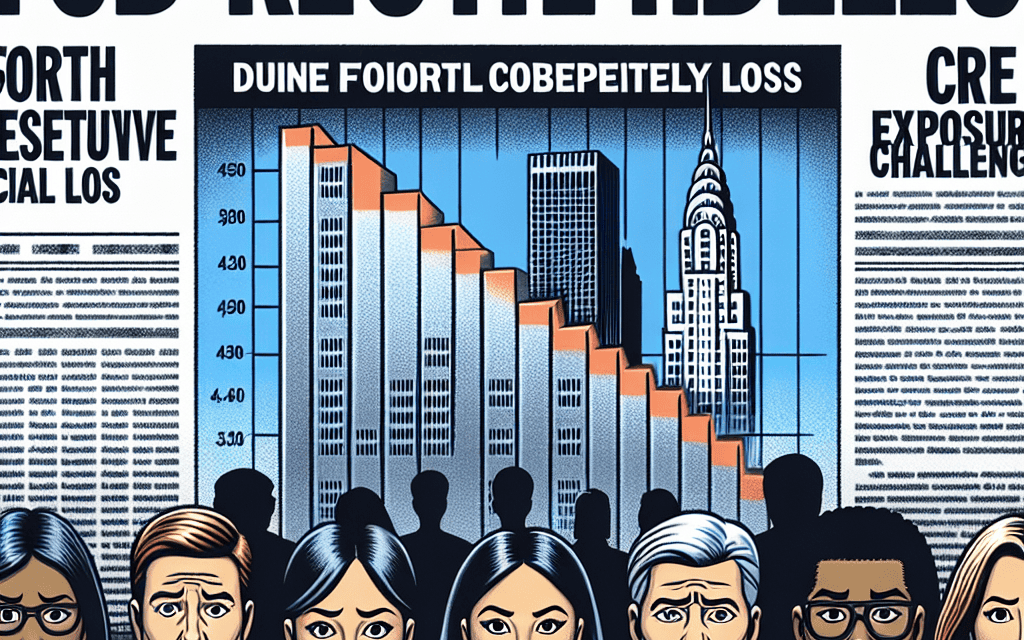“NYCB Faces Headwinds: CRE Exposure Drives Fourth Straight Quarterly Loss”
Introduction
New York Community Bancorp (NYCB) has reported its fourth consecutive quarterly loss, primarily attributed to ongoing challenges in its commercial real estate (CRE) exposure. The financial institution has been grappling with a difficult market environment, marked by fluctuating property values and increased vacancy rates, which have adversely impacted its loan portfolio. This persistent downturn in the CRE sector has led to heightened provisions for credit losses, further straining NYCB’s financial performance. As the bank navigates these turbulent conditions, it continues to explore strategic measures to mitigate risks and stabilize its earnings trajectory.
Impact Of CRE Exposure On NYCB’s Financial Health
New York Community Bancorp (NYCB) has recently reported its fourth consecutive quarterly loss, a situation primarily attributed to its significant exposure to the commercial real estate (CRE) sector. This persistent financial downturn has raised concerns among investors and analysts, prompting a closer examination of the underlying factors contributing to the bank’s current predicament. As the CRE market faces ongoing challenges, NYCB’s financial health remains under scrutiny, with its substantial involvement in this sector playing a pivotal role in its recent performance.
To understand the impact of CRE exposure on NYCB’s financial health, it is essential to consider the broader economic context. The commercial real estate market has been grappling with a series of disruptions, including fluctuating property values, rising interest rates, and changing demand patterns. These factors have collectively exerted pressure on financial institutions heavily invested in CRE, with NYCB being no exception. The bank’s extensive portfolio of commercial real estate loans has made it particularly vulnerable to these market dynamics, resulting in increased loan delinquencies and a subsequent rise in credit loss provisions.
Moreover, the pandemic-induced shift in work and lifestyle patterns has further complicated the CRE landscape. As remote work becomes more prevalent, the demand for office spaces has diminished, leading to higher vacancy rates and declining rental incomes. This trend has adversely affected property owners’ ability to meet their financial obligations, thereby impacting lenders like NYCB. Consequently, the bank has had to navigate a challenging environment where the risk of default on CRE loans has heightened, necessitating a more cautious approach to lending and risk management.
In addition to these market-specific challenges, regulatory pressures have also played a role in shaping NYCB’s financial trajectory. Stricter regulatory requirements have compelled banks to maintain higher capital reserves, particularly for riskier assets such as CRE loans. This has further constrained NYCB’s ability to generate income from its commercial real estate portfolio, as the need to allocate more capital towards risk mitigation has limited its lending capacity. As a result, the bank has faced a delicate balancing act between managing regulatory compliance and pursuing growth opportunities within the CRE sector.
Despite these challenges, NYCB has been actively exploring strategies to mitigate the impact of its CRE exposure on its financial health. The bank has been diversifying its loan portfolio by increasing its focus on residential mortgage lending and other less volatile sectors. This strategic shift aims to reduce its reliance on commercial real estate and enhance its overall resilience to market fluctuations. Additionally, NYCB has been investing in technology and digital banking solutions to improve operational efficiency and customer engagement, thereby positioning itself for long-term growth.
In conclusion, NYCB’s fourth consecutive quarterly loss underscores the significant impact of CRE exposure on its financial health. The bank’s substantial involvement in the commercial real estate sector has rendered it susceptible to market volatility and regulatory pressures, resulting in increased credit risk and constrained lending capacity. However, through strategic diversification and investment in technology, NYCB is taking proactive steps to navigate these challenges and strengthen its financial position. As the CRE market continues to evolve, the bank’s ability to adapt and innovate will be crucial in determining its future success and stability.
Strategies For NYCB To Mitigate CRE-Related Losses
New York Community Bancorp (NYCB) has recently reported its fourth consecutive quarterly loss, primarily attributed to its significant exposure to the commercial real estate (CRE) sector. This persistent financial challenge underscores the need for strategic measures to mitigate CRE-related losses and stabilize the bank’s financial health. As the CRE market continues to face headwinds, NYCB must adopt a multifaceted approach to navigate these turbulent times effectively.
To begin with, diversifying the bank’s loan portfolio is a crucial step in reducing its dependency on the volatile CRE market. By expanding into other lending areas such as residential mortgages, consumer loans, and small business financing, NYCB can spread its risk across a broader spectrum of assets. This diversification not only mitigates the impact of CRE market fluctuations but also opens up new revenue streams, thereby enhancing the bank’s overall financial resilience.
In addition to diversification, NYCB should consider strengthening its risk management practices. Implementing more stringent credit assessment procedures and regularly reviewing the performance of existing CRE loans can help identify potential problem areas before they escalate. By proactively managing its loan portfolio, the bank can take corrective actions, such as restructuring loans or increasing loan loss provisions, to cushion against potential defaults. Furthermore, leveraging advanced data analytics and predictive modeling can provide deeper insights into market trends and borrower behavior, enabling more informed decision-making.
Another strategic avenue for NYCB is to enhance its capital position. A robust capital buffer can absorb potential losses and provide a safety net during economic downturns. The bank could explore options such as issuing new equity or subordinated debt to bolster its capital reserves. Additionally, retaining earnings by reducing dividend payouts temporarily could also contribute to strengthening the capital base. A solid capital position not only instills confidence among investors and regulators but also provides the bank with greater flexibility to navigate challenging market conditions.
Moreover, NYCB should focus on building stronger relationships with its CRE clients. By maintaining open lines of communication and offering tailored financial solutions, the bank can better understand the unique challenges faced by its clients and work collaboratively to address them. This client-centric approach not only helps in managing existing risks but also positions NYCB as a trusted partner, potentially leading to new business opportunities in the future.
Furthermore, exploring strategic partnerships or alliances with other financial institutions could provide NYCB with additional resources and expertise to manage its CRE exposure more effectively. Collaborations could involve sharing best practices, co-lending arrangements, or even joint ventures in specific CRE projects. Such partnerships can enhance the bank’s capabilities and provide access to new markets, thereby reducing its reliance on its existing CRE portfolio.
Lastly, NYCB should remain vigilant about regulatory developments and ensure compliance with evolving standards. Staying abreast of regulatory changes and adapting internal policies accordingly can prevent potential legal and financial repercussions. Engaging with regulators proactively and participating in industry forums can also provide valuable insights and help shape a more favorable regulatory environment.
In conclusion, while NYCB’s current financial challenges stemming from its CRE exposure are significant, they are not insurmountable. By adopting a comprehensive strategy that includes diversification, enhanced risk management, capital strengthening, client engagement, strategic partnerships, and regulatory compliance, NYCB can mitigate its CRE-related losses and pave the way for a more stable and prosperous future.
Analyzing NYCB’s Quarterly Loss Trends
New York Community Bancorp (NYCB) has reported its fourth consecutive quarterly loss, a trend that has raised concerns among investors and analysts alike. This persistent financial downturn is primarily attributed to the bank’s significant exposure to the commercial real estate (CRE) sector, which has been facing substantial challenges. As the economic landscape continues to evolve, understanding the factors contributing to NYCB’s losses is crucial for stakeholders seeking to navigate the complexities of the banking industry.
To begin with, the CRE sector has been under considerable pressure due to a combination of factors, including rising interest rates, changing work patterns, and shifts in consumer behavior. These elements have collectively led to a decrease in demand for commercial properties, thereby affecting the valuation and profitability of assets held by financial institutions like NYCB. As a bank with a substantial portion of its loan portfolio tied to CRE, NYCB has been particularly vulnerable to these market dynamics. Consequently, the bank has faced increased loan delinquencies and defaults, which have directly impacted its financial performance.
Moreover, the broader economic environment has not been conducive to a swift recovery in the CRE market. The Federal Reserve’s monetary policy, aimed at curbing inflation, has resulted in higher borrowing costs. This has further strained the CRE sector, as developers and property owners grapple with increased financing expenses. For NYCB, this has translated into a challenging operating environment, where the cost of capital has risen while the returns on CRE investments have diminished. As a result, the bank’s net interest margin has been compressed, contributing to its ongoing quarterly losses.
In addition to external economic pressures, NYCB’s internal strategies have also played a role in its financial struggles. The bank’s historical focus on CRE lending, while once a lucrative niche, has now become a double-edged sword. As the market has shifted, NYCB has found itself overexposed to a sector that is currently underperforming. This concentration risk has limited the bank’s ability to diversify its revenue streams and mitigate the impact of CRE-related losses. Furthermore, efforts to pivot towards other lending areas, such as residential mortgages or consumer loans, have been met with mixed results, as competition in these segments remains fierce.
Despite these challenges, NYCB has been taking steps to address its financial woes. The bank has been actively working to restructure its loan portfolio, aiming to reduce its reliance on CRE and enhance its risk management practices. Additionally, NYCB has been exploring opportunities to strengthen its capital position, including potential asset sales and strategic partnerships. While these initiatives are still in their early stages, they represent a proactive approach to navigating the current economic landscape.
Looking ahead, the path to recovery for NYCB will likely depend on a combination of external market conditions and internal strategic adjustments. As the CRE sector gradually stabilizes, there may be opportunities for the bank to regain its footing and return to profitability. However, this will require careful management of its existing assets and a keen focus on diversifying its business model. In the meantime, stakeholders will be closely monitoring NYCB’s performance, as the bank endeavors to overcome the challenges posed by its CRE exposure and achieve sustainable growth in the future.
The Role Of Commercial Real Estate In NYCB’s Financial Performance

New York Community Bancorp (NYCB) has recently reported its fourth consecutive quarterly loss, a situation largely attributed to its significant exposure to the commercial real estate (CRE) sector. This persistent financial downturn underscores the intricate relationship between NYCB’s performance and the broader dynamics of the commercial real estate market. As the bank navigates these challenges, it becomes imperative to understand the role that CRE plays in shaping its financial outcomes.
To begin with, NYCB has long been recognized for its substantial investment in commercial real estate, a strategy that has historically provided robust returns. However, the current economic climate has introduced a series of challenges that have adversely affected this sector. The ongoing impact of the COVID-19 pandemic, coupled with shifting work patterns and evolving consumer behaviors, has led to increased vacancies and declining property values in certain segments of the CRE market. Consequently, these factors have exerted pressure on NYCB’s financial performance, as the bank’s portfolio is heavily weighted towards commercial real estate loans.
Moreover, the rising interest rate environment has further complicated the situation for NYCB. As interest rates increase, the cost of borrowing also rises, which can lead to a slowdown in real estate transactions and development projects. This, in turn, affects the demand for commercial real estate loans, thereby impacting NYCB’s revenue streams. Additionally, higher interest rates can lead to increased defaults on existing loans, as borrowers may struggle to meet their financial obligations. This scenario has necessitated a more cautious approach from NYCB, as it seeks to mitigate potential risks associated with its CRE exposure.
In light of these challenges, NYCB has been compelled to reassess its strategic priorities. The bank is exploring diversification opportunities to reduce its reliance on the commercial real estate sector. By expanding its focus to include other areas such as residential mortgages and consumer lending, NYCB aims to create a more balanced portfolio that can withstand market fluctuations. This strategic pivot is essential for enhancing the bank’s resilience and ensuring long-term financial stability.
Furthermore, NYCB is actively engaging in risk management practices to address the vulnerabilities associated with its CRE exposure. This includes conducting thorough assessments of its loan portfolio, implementing stringent underwriting standards, and closely monitoring market trends. By adopting these measures, NYCB seeks to safeguard its assets and minimize potential losses.
Despite the current challenges, it is important to recognize that commercial real estate remains a vital component of NYCB’s business model. The bank’s expertise in this sector has been a key driver of its growth over the years, and it continues to offer significant opportunities for revenue generation. As the market gradually stabilizes, NYCB is well-positioned to capitalize on emerging trends and leverage its strengths in commercial real estate.
In conclusion, the role of commercial real estate in NYCB’s financial performance is both complex and multifaceted. While the bank faces ongoing challenges due to its CRE exposure, it is actively pursuing strategies to adapt to the evolving market landscape. Through diversification, risk management, and strategic realignment, NYCB is working to overcome its current financial setbacks and pave the way for a more resilient future. As the bank continues to navigate these turbulent times, its ability to effectively manage its commercial real estate portfolio will be crucial in determining its long-term success.
NYCB’s Risk Management Approaches In The Face Of CRE Challenges
New York Community Bancorp (NYCB) has recently reported its fourth consecutive quarterly loss, a situation largely attributed to its significant exposure to the commercial real estate (CRE) sector. This persistent financial challenge has prompted the bank to reassess and refine its risk management strategies to mitigate the adverse impacts of its CRE portfolio. As the CRE market continues to face headwinds, NYCB’s approach to risk management has become a focal point for stakeholders seeking to understand how the bank plans to navigate these turbulent waters.
To begin with, NYCB has recognized the necessity of enhancing its risk assessment frameworks. The bank has invested in advanced analytics and data-driven tools to better evaluate the potential risks associated with its CRE holdings. By leveraging these technologies, NYCB aims to gain a more comprehensive understanding of market trends and property valuations, thereby enabling more informed decision-making. This proactive approach is intended to identify potential vulnerabilities in the portfolio before they manifest into significant financial losses.
Moreover, NYCB has placed a strong emphasis on diversifying its CRE portfolio. Recognizing that concentration in specific property types or geographic regions can exacerbate risk, the bank is actively seeking to broaden its exposure across various asset classes and locations. This diversification strategy is designed to spread risk more evenly and reduce the impact of localized market downturns. By doing so, NYCB hopes to create a more resilient portfolio that can better withstand economic fluctuations.
In addition to diversification, NYCB is also focusing on strengthening its underwriting standards. The bank has implemented more stringent criteria for new CRE loans, ensuring that only projects with robust financial fundamentals and strong sponsorship are considered. This cautious approach is aimed at minimizing the likelihood of defaults and preserving the quality of the loan portfolio. Furthermore, NYCB is conducting regular stress tests to evaluate the potential impact of adverse economic scenarios on its CRE assets. These stress tests are crucial for identifying potential weaknesses and preparing contingency plans to address them.
Another key component of NYCB’s risk management strategy is enhancing its liquidity position. The bank has taken steps to bolster its capital reserves, providing a buffer against potential losses. By maintaining a strong liquidity profile, NYCB is better positioned to absorb shocks and continue operations without compromising its financial stability. This focus on liquidity is particularly important given the uncertain economic environment and the potential for further disruptions in the CRE market.
Furthermore, NYCB is actively engaging with its borrowers to address potential challenges early on. By maintaining open lines of communication, the bank can work collaboratively with borrowers to restructure loans or provide temporary relief measures when necessary. This proactive engagement not only helps borrowers navigate difficult times but also protects the bank’s interests by reducing the likelihood of defaults.
In conclusion, NYCB’s response to its CRE exposure challenges underscores the importance of a multifaceted risk management approach. By enhancing risk assessment capabilities, diversifying its portfolio, strengthening underwriting standards, bolstering liquidity, and engaging with borrowers, the bank is taking comprehensive steps to mitigate the impact of its CRE exposure. While the road to recovery may be challenging, these strategies reflect NYCB’s commitment to navigating the complexities of the CRE market and safeguarding its financial health. As the bank continues to adapt to evolving market conditions, its risk management efforts will remain a critical component of its overall strategy.
Investor Reactions To NYCB’s Consecutive Quarterly Losses
New York Community Bancorp (NYCB) recently reported its fourth consecutive quarterly loss, a development that has sparked varied reactions among investors. The primary factor contributing to these losses is the bank’s significant exposure to the commercial real estate (CRE) sector, which has been facing numerous challenges. As the CRE market grapples with issues such as rising interest rates, changing work patterns, and economic uncertainties, NYCB’s financial performance has been adversely affected. Consequently, investors are closely scrutinizing the bank’s strategies and future prospects.
In light of these consecutive losses, some investors have expressed concern over NYCB’s ability to navigate the current economic landscape. The bank’s substantial involvement in the CRE sector, which has been particularly vulnerable to recent market shifts, has raised questions about its risk management practices. Investors are keenly aware that the CRE market’s struggles are not isolated incidents but part of a broader trend affecting many financial institutions. As a result, there is a growing demand for NYCB to reassess its portfolio and consider diversifying its investments to mitigate potential risks.
On the other hand, some investors remain cautiously optimistic about NYCB’s long-term prospects. They argue that the bank’s extensive experience in the CRE sector could eventually work to its advantage once the market stabilizes. These investors believe that NYCB’s deep-rooted relationships and expertise in managing CRE assets could position it well for a rebound when economic conditions improve. Furthermore, they point out that the bank’s management has already begun implementing measures to address the current challenges, such as tightening lending standards and exploring opportunities in other sectors.
Despite these differing perspectives, there is a consensus among investors that transparency and communication from NYCB’s management are crucial during this period of uncertainty. Investors are eager for detailed insights into the bank’s strategic plans and how it intends to address the ongoing challenges in the CRE market. Regular updates and clear communication can help build confidence and provide reassurance to stakeholders who are concerned about the bank’s financial health.
Moreover, the broader economic environment continues to play a significant role in shaping investor sentiment. With interest rates on the rise and inflationary pressures persisting, the financial sector as a whole is facing headwinds. Investors are acutely aware that these macroeconomic factors can exacerbate the difficulties faced by banks like NYCB, which are heavily invested in sectors sensitive to such changes. Consequently, they are closely monitoring economic indicators and policy decisions that could impact the bank’s performance in the coming quarters.
In conclusion, NYCB’s fourth consecutive quarterly loss has elicited a range of reactions from investors, reflecting both concern and cautious optimism. While some are worried about the bank’s exposure to the troubled CRE sector, others see potential for recovery once market conditions improve. Regardless of their stance, investors agree on the importance of transparency and effective communication from NYCB’s management. As the bank navigates these challenging times, its ability to adapt and respond to both internal and external pressures will be critical in shaping investor confidence and determining its future trajectory.
Future Outlook For NYCB Amidst CRE Exposure Issues
New York Community Bancorp (NYCB) has recently reported its fourth consecutive quarterly loss, primarily attributed to its significant exposure to the commercial real estate (CRE) sector. This persistent financial challenge has raised concerns among investors and analysts about the bank’s future outlook. As the CRE market continues to face headwinds, NYCB’s strategic decisions and adaptability will be crucial in navigating these turbulent times.
The CRE sector has been under pressure due to a combination of factors, including rising interest rates, changing work patterns, and economic uncertainties. These elements have collectively contributed to a decline in property values and rental incomes, thereby impacting the financial performance of institutions heavily invested in this sector. For NYCB, which has a substantial portion of its loan portfolio tied to CRE, these challenges have translated into increased loan delinquencies and reduced profitability.
In response to these difficulties, NYCB has been actively exploring various strategies to mitigate the impact of its CRE exposure. One approach has been to diversify its loan portfolio by increasing its focus on other sectors, such as residential mortgages and small business lending. By doing so, the bank aims to reduce its reliance on the volatile CRE market and create a more balanced and resilient portfolio. Additionally, NYCB has been enhancing its risk management practices to better identify and address potential issues within its CRE holdings.
Moreover, the bank has been working on strengthening its capital position to withstand potential losses. This includes efforts to improve its liquidity and capital ratios, which are essential for maintaining financial stability in uncertain times. By bolstering its capital reserves, NYCB aims to reassure investors and regulators of its ability to manage risks effectively and sustain operations despite ongoing challenges.
Furthermore, NYCB is also focusing on technological advancements to improve operational efficiency and customer service. By investing in digital banking solutions and streamlining processes, the bank seeks to enhance its competitive edge and attract a broader customer base. This digital transformation is expected to not only reduce operational costs but also provide new revenue streams, thereby supporting the bank’s long-term growth objectives.
In addition to these internal measures, NYCB is closely monitoring external developments that could influence its future performance. The bank is keeping a watchful eye on regulatory changes, economic trends, and market dynamics that may affect the CRE sector and the broader financial landscape. By staying informed and agile, NYCB aims to adapt its strategies promptly to capitalize on emerging opportunities and mitigate potential risks.
While the road ahead may be fraught with challenges, NYCB’s proactive approach to addressing its CRE exposure issues demonstrates its commitment to ensuring a sustainable future. The bank’s efforts to diversify its portfolio, strengthen its capital position, and embrace technological innovation are steps in the right direction. However, the effectiveness of these strategies will largely depend on the broader economic environment and the bank’s ability to execute its plans efficiently.
In conclusion, NYCB’s future outlook amidst CRE exposure challenges remains cautiously optimistic. While the bank faces significant hurdles, its strategic initiatives and focus on adaptability provide a foundation for potential recovery and growth. As the CRE market continues to evolve, NYCB’s resilience and strategic foresight will be key determinants of its success in navigating this complex landscape.
Q&A
1. **What is the main reason for NYCB’s fourth consecutive quarterly loss?**
The main reason for NYCB’s fourth consecutive quarterly loss is challenges related to its commercial real estate (CRE) exposure.
2. **How many consecutive quarters has NYCB reported a loss?**
NYCB has reported a loss for four consecutive quarters.
3. **What type of exposure is primarily affecting NYCB’s financial performance?**
NYCB’s financial performance is primarily affected by its exposure to commercial real estate (CRE).
4. **Has NYCB taken any measures to address the CRE exposure challenges?**
The specific measures taken by NYCB to address the CRE exposure challenges are not detailed in the question.
5. **What impact has the CRE exposure had on NYCB’s overall financial health?**
The CRE exposure has negatively impacted NYCB’s overall financial health, contributing to consecutive quarterly losses.
6. **Is NYCB’s loss trend expected to continue in the future?**
The question does not provide information on future expectations regarding NYCB’s loss trend.
7. **What sector is primarily responsible for NYCB’s financial difficulties?**
The commercial real estate (CRE) sector is primarily responsible for NYCB’s financial difficulties.
Conclusion
New York Community Bancorp (NYCB) has reported its fourth consecutive quarterly loss, primarily attributed to challenges in its commercial real estate (CRE) exposure. The persistent losses highlight the ongoing difficulties faced by the bank in managing its CRE portfolio, which has been impacted by market volatility and economic uncertainties. This trend underscores the need for strategic adjustments and risk management enhancements to stabilize financial performance and mitigate future losses. The situation calls for a reassessment of the bank’s investment strategies and a potential diversification of its asset base to reduce dependency on the CRE sector.





